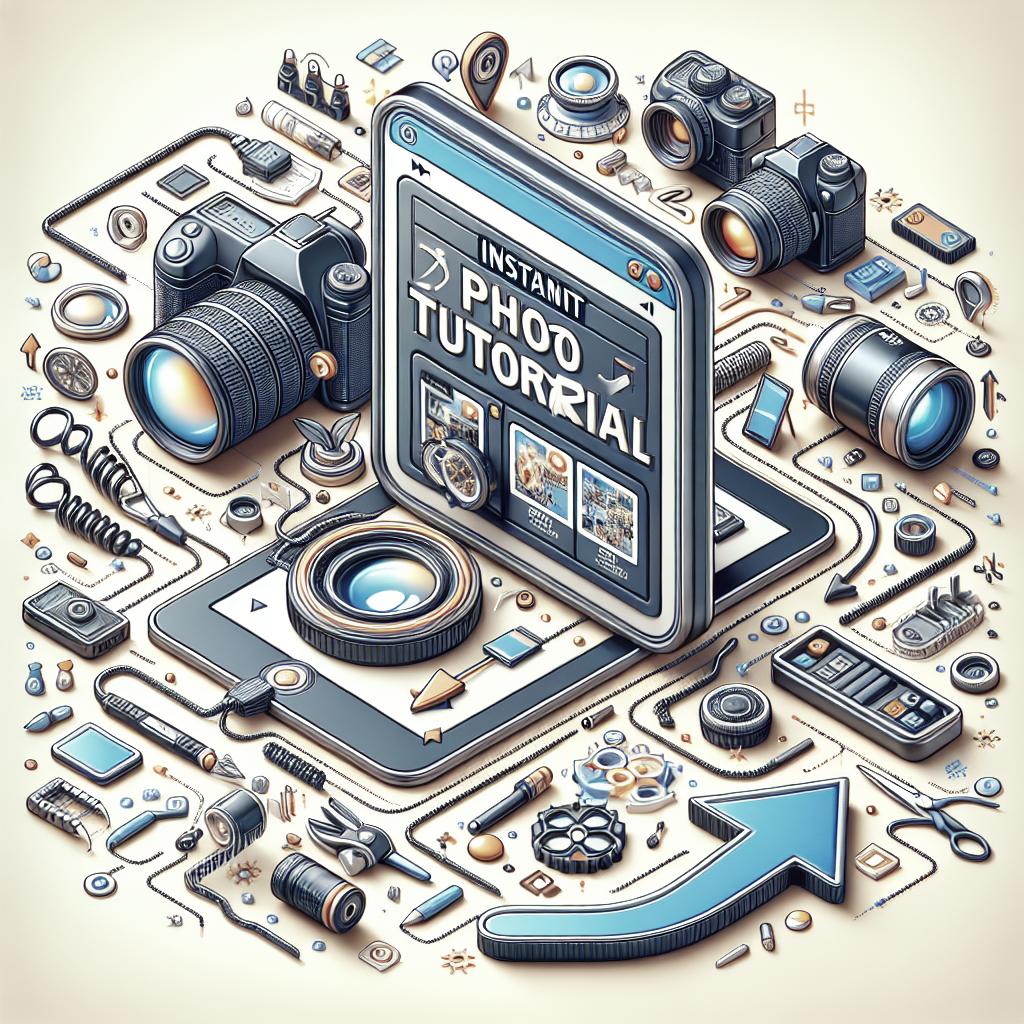Where to Find an Instant Photo Tutorial Instant film photography has recently seen a resurgence, fueled by a mixture of nostalgia and a love for its tangible and often quirky results. This blog post dives deep into the world of instant film, starting with its illustrious history and renewed popularity. We’ll explore various instant film formats, such as Fuji Instax and Polaroid 600, and provide essential tips for buying a used camera. Following that, we’ll break down the basics of instant film photography to get you started and stress the importance of practice. By the end, you’ll have a clear roadmap to mastering this captivating art form.
The History and Resurgence of Instant Film Photography
Instant film photography began in the late 1940s with Polaroid’s invention of the first instant camera. This revolutionized the way people captured memories, offering almost immediate gratification. In the years that followed, Polaroid became a household name, synonymous with instant photography. However, as digital cameras gained traction, instant film saw a decline. The resurgence of instant film photography can be attributed to a renewed appreciation for analog methods and the unique charm of instant prints. Enthusiasts are drawn to the tactile experience and the unpredictability that comes with each shot. Today, brands like Polaroid Originals and Fuji Instax lead the charge, offering modern takes on classic film formats, making instant photography more accessible than ever.
A Variety Of Instant Film Formats
Fuji Instax
Fuji Instax has become a popular choice for instant film aficionados. Known for its affordability and reliability, Fuji Instax cameras come in several formats, including Mini, Square, and Wide. The Mini format is particularly suitable for casual photographers, thanks to its compact size and wallet-friendly price point. Each shot is a little work of art, with vibrant colors and fine detail that makes every moment memorable. The Square format, closer in size to the classic Polaroid prints, offers a contemporary twist on a nostalgic product. This format is perfect for those who want a larger, more substantial print size but still appreciate the convenience of an instant camera. The Wide format, on the other hand, is ideal for landscapes and group photos, providing larger prints.
Polaroid 600 Cameras
Polaroid 600 cameras are icons of the instant photography world. First introduced in the 1980s, they have a distinctive, boxy design that has become instantly recognizable. The 600 film itself offers rich colors and distinct contrasts, making each shot a vivid representation of the moment. With numerous models available, from the original 600 series to modern iterations by Polaroid Originals, there’s a camera for every kind of photographer. Moreover, the Polaroid 600 series often comes with features like autofocus, auto-exposure, and even built-in flash, making it incredibly user-friendly. Whether you’re a novice or a seasoned photographer, you’ll find these features handy for capturing high-quality shots effortlessly.
Polaroid SX-70
The Polaroid SX-70 is a classic for a reason. First released in 1972, it was among the first cameras to use SX-70 integral film, which developed images without the need for intervention. What sets this camera apart is its folding design, allowing for better portability. Often celebrated for its superior build quality and aesthetics, the SX-70 is beloved by photographers who crave manual control. It offers a blend of modern sensibilities and vintage charm, enabling photographers to adjust focus and exposure settings to achieve the perfect shot. Though it requires more skill and understanding, the results are worth the effort.
Polaroid SLR680/SLR690
The Polaroid SLR680 and SLR690 are evolutionary steps in the SX-70 lineage, integrating autofocus and a built-in flash for ease of use. The SLR680, introduced in the late 1980s, combines the manual charm of earlier models with advanced features like sonar autofocus and an electronic flash, making it one of the most user-friendly Polaroid cameras available. The SLR690, while less common, takes these features a step further. It’s essentially a hybrid between the SX-70 and 600 series, using 600 film and offering the vintage aesthetics that many photographers admire. Both models are cherished for their unique combination of manual control and modern convenience, making them ideal for hobbyists and professionals alike.
Tips for Buying a Used Instant Film Camera
When buying a used instant film camera, the first thing to look for is the camera’s physical condition. Given the age of many classic models, wear and tear are expected. However, significant damage can affect functionality. Inspect the camera for any cracks, corrosion, or missing components. It’s also wise to check the battery compartments for leakage, which can be a red flag. Next, ensure the camera’s mechanics are working. For example, with Polaroid models, you’ll want to verify that the rollers are functioning correctly and that the viewfinder is clean and clear. Test the camera with a film pack if possible. Many sellers offer return policies or warranties, which can provide peace of mind when making your purchase. Finally, consider the seller’s reputation. Buying from a reputable source, whether it’s an online marketplace or a dedicated camera shop, can make all the difference. Read reviews and ask for any return or warranty policies they might offer. Doing a bit of homework can lead to a much more satisfying photography experience.
Understanding the Basics of Instant Film Photography
Understanding the basics is crucial to making the most out of your instant film camera. First, familiarize yourself with your camera’s controls and functionalities. Different models offer unique features—such as manual focus, adjustable exposure, or built-in flashes—that can significantly impact your photos. Next, consider lighting. Instant film is particularly sensitive to light; poor lighting conditions can lead to underexposed or overexposed photographs. Make use of natural light when available, and don’t hesitate to experiment with the camera’s flash settings as needed. Remember that instant film photography is as much about trial and error as it is about capturing perfect moments. Lastly, composition is key. Just like with digital photography, framing your shot plays a critical role in the outcome. Given the finite number of shots per film pack, it’s important to plan your composition carefully. Pay attention to the rule of thirds, leading lines, and perspective to make your images compelling and captivating.
Practice, Practice, Practice
One of the most essential aspects of mastering instant film photography is consistent practice. The more you shoot, the more familiar you’ll become with your camera’s quirks and best practices. Make it a habit to take your camera with you on various excursions—whether it’s a casual outing or a planned photoshoot. Experimentation is a huge part of the learning curve in instant film photography. Try capturing shots in different lighting conditions, and play around with various settings to see how they affect your results. Each photograph will serve as feedback, helping you understand what works and what doesn’t, and gradually improving your skills. In addition to developing technical skills, frequent practice will also help you cultivate your unique style. Over time, you’ll begin to understand your preferences for subjects, lighting, and composition, allowing your photography to become a true reflection of your artistic vision.
Final Thoughts
In wrapping up, it’s clear that instant film photography offers a uniquely rewarding experience for both novices and seasoned photographers. From exploring the various film formats like Fuji Instax and Polaroid cameras to acquiring a used camera wisely, there’s much to learn and enjoy. Coupled with a solid understanding of the photography basics and a commitment to practice, you can truly master this captivating art form. Here’s a summarized breakdown for easy reference: “`html
| Topic | Main Points |
|---|---|
| History and Resurgence | Polaroid invention, decline due to digital cameras, renewed interest from nostalgia and unique appeal. |
| Instant Film Formats | Fuji Instax (Mini, Square, Wide), Polaroid 600, Polaroid SX-70, Polaroid SLR680/SLR690. |
| Buying a Used Camera | Check physical condition, test mechanics, buy from reputable sellers. |
| Basics of Instant Photography | Familiarize with the camera, consider lighting, focus on composition. |
| Practice | Consistent practice, experimentation, develop personal style. |
“`


